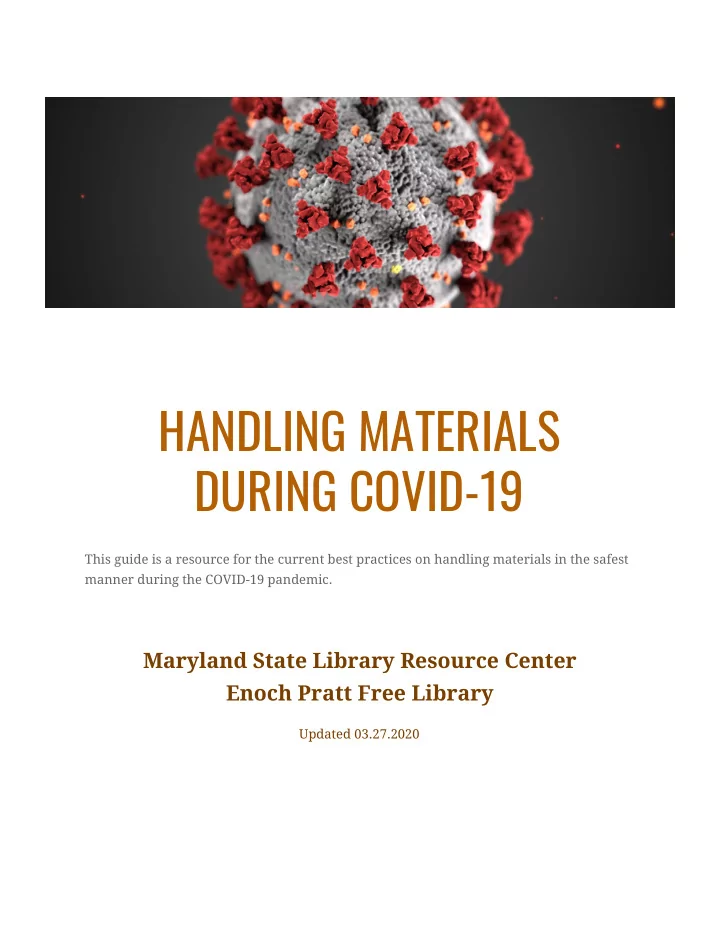

HANDLING MATERIALS DURING COVID-19 This guide is a resource for the current best practices on handling materials in the safest manner during the COVID-19 pandemic. Maryland State Library Resource Center Enoch Pratt Free Library Updated 03.27.2020
SAFETY FIRST Please be sure to use gloves at all times while handling incoming material for safety. Make sure you don’t touch your face while having gloves on. Wash your hands shortly after removing gloves. Continue practicing social distancing when working with others. RETURNED MATERIAL - QUARANTINE PROCEDURE 1. Establish a quarantine area for returned materials and ensure staff know where it is located to avoid contact. 2. Put on gloves. Prepare a slip for the cart for incoming materials, noting the date and time. Add additional signage to the cart as needed so that staff do not accidentally handle the material. 3. Retrieve materials from the book drop. Place items on the cart. 4. Avoid contact with door handles and other contact points after you’ve touched materials. Move the cart to the identified quarantine area. 5. Remove gloves and promptly wash your hands. 6. After items have been on the cart for a minimum of 72 hours, you can return the items in your ILS and shelve them as normal. In lab testing, the presence of the virus is gone after 72 hours on plastic and stainless steel and 24 hours on cardboard. 1 If you do not have enough space to quarantine carts in your workroom, you can use bags to contain the items for 72 hours. 2 Some libraries are using their meeting and study rooms in the interim. NEW MATERIAL - QUARANTINE PROCEDURE 1. Establish a quarantine area for your incoming materials from vendors and ensure staff know where it is located to avoid contact. 2. Put on gloves. Prepare a slip for the cart for new materials, noting the date and time. Add additional signage to the cart as needed so that staff do not accidentally handle the material. 3. Unbox materials from your shipment. Place items on the cart. 4. Recycle or throw away the cardboard box. Since the virus can live on cardboard for up to 24 hours, staff emptying recycle bins or trash cans should take precaution and wear gloves when handling collection and disposal.
5. Avoid contact with door handles and other contact points after you’ve touched cardboard and the new materials. Move the cart to the identified quarantine area for new materials. 6. Remove gloves and promptly wash your hands. 7. After new items have been on the cart for a minimum of 72 hours, you can process and shelve them as normal. CLEANING VS. SANITIZING MATERIALS Disinfectant wipes or liquid disinfectants may damage books. 2 “There are no studies that specifically answer the question of how transmissible COVID19 might be from the most common library materials – for example coated and uncoated paper, bookcloth, or polyester book jackets. Quarantine of materials for 72 or more hours seems to be the safest course. … There is very little research on the effects of medically effective sterilization and sanitization measures on the condition of library materials, another reason to favor quarantine.” - Jacob Nadal, Director for Preservation, The Library of Congress 3 ADDITIONAL RESOURCES/ARTICLES Handling Library Materials and Collections During a Pandemic (ALA) Upcoming Webinar - March 30, 2020, 1 pm-2pm ET - Mitigating COVID-19 When Managing Paper-Based, Circulating, and Other Types of Collections (IMLS) Recommendations for Disinfecting Books (Northeast Document Conservation Center) Coronavirus Can Live For A Long Time In Air, On Surfaces (NPR) How long does coronavirus live on different surfaces? (The Guardian)
REFERENCES 1. van Doremalen, N., Morris, D. H., Holbrook, M. G., Gamble, A., Williamson, B. N., Tamin, A., Harcourt, J. L., Thornburg, N. J., Gerber, S. I., Lloyd-Smith, J. O., de Wit, E., Munster, V. J. (2020, March 17). Aerosol and surface stability of SARS-CoV-2 as compared with SARS-CoV-1. The New England Journal of Medicine . doi:10.1056/NEJMc2004973 2. Disinfecting circulating books. (2020). Retrieved from http://www.ala.org/alcts/sites/ala.org.alcts/files/content/UPDATE_NEDCC%20recom mendations%20for%20disinfecting%20books_Mar2020-converted.pdf 3. Nadal, J. (2020, March 25). [Electronic mailing list message]. Retrieved from https://archive.mail-list.com/ulc-collections
Recommend
More recommend